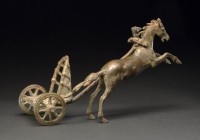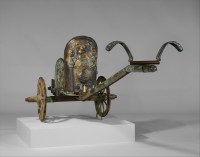 A study of a bronze model of a Roman racing chariot dating to the 1st-2nd c. A.D. has revealed new information on how the vehicles were built. The model, recovered from the Tiber in the 1890s, is now in the collection of the British Museum. It is a biga, a two-horse chariot, although one of the original horse figures is missing, as is the charioteer. The piece is a petite 10 inches long and eight inches high, but its significance is as oversized as the model is small.
A study of a bronze model of a Roman racing chariot dating to the 1st-2nd c. A.D. has revealed new information on how the vehicles were built. The model, recovered from the Tiber in the 1890s, is now in the collection of the British Museum. It is a biga, a two-horse chariot, although one of the original horse figures is missing, as is the charioteer. The piece is a petite 10 inches long and eight inches high, but its significance is as oversized as the model is small.
While the remains of close to 300 ancient Etruscan and Italian war and ceremonial chariots have been discovered in funerary contexts, no racing chariots from Republican or Imperial Rome have ever been found. Written descriptions and visual representations are all we have to go on to understand how they were constructed. Most of the chariots depicted in monumental art are triumphal chariots which were used in solemn processionals and bore only a superficial resemblance (ie, number of wheels, long axle) to the racing chariot. Racing chariots are depicted in carved reliefs, frescoes and mosaics of circus race scenes.
 The little Tiber model, with its precision details and proportions, is the greatest source of information we have about the Roman racing chariot. It was a luxury item, the kind of toy chariot that only the very wealthy could afford. (Nero was fond of toy chariots, according to Suetonius, although his were ivory.) The wheels, now fixed, turned on the axle so it could be vigorously vroom-vroomed by its owner. Its creator certainly knew a great deal about chariot construction.
The little Tiber model, with its precision details and proportions, is the greatest source of information we have about the Roman racing chariot. It was a luxury item, the kind of toy chariot that only the very wealthy could afford. (Nero was fond of toy chariots, according to Suetonius, although his were ivory.) The wheels, now fixed, turned on the axle so it could be vigorously vroom-vroomed by its owner. Its creator certainly knew a great deal about chariot construction.
It has a long, straight axle, small wheels to help keep the base stable around tight corners, a small body, low to the ground, just big enough to fit one man snugly. The yoke pole has a decorative ram’s head at the end of it. The front of the car wasn’t the solid, highly decorated panel reaching Charlton Heston’s armpits seen in big screen versions of Roman chariot races. The car was basically a frame, bent pieces of wood lashed together. The front had a piece of leather or fabric tied to the frame, while the floor was woven straps which provided a little much-needed springiness for the charioteer.
Close examination of the model in the new study found that the right wheel, and only the right wheel, had a thin iron rim surrounding the wood.
“The basic wheels were always of wood, animal hide glue, and rawhide strips (at critical joints) that tighten upon drying, like clamps,” explained author Bela Sandor, professor emeritus of engineering physics at the University of Wisconsin at Madison. “Any iron tire for racing would be a very thin strip of iron on the outside of the wooden rim, best when heat-shrunk on the wood, to consolidate the whole wheel.
Adding the strip of iron to the right wheel improved a charioteer’s chances of winning a race to roughly 80 percent, according to a study published in the latest issue of the Journal of Roman Archaeology. […]
Since it was easier to guide the horses into left-turning bends, most races ran anti-clockwise. “Indeed, the right side tire works best in oval-shaped arenas if the turning is always leftward,” Sandor said.
Sandor explained that some of the Romans strengthened the right wheels only because all chariots leaned to the right and overloaded just the right wheels during the left turns. “This makes total sense to everybody who understands the dynamics of a turning vehicle. It’s a common sensation to people riding in a fast-turning vehicle; standing and lurching sideways in a turning bus is a good example,” Sandor said.
 The right-side iron tire didn’t necessarily make the chariot move faster. Its job was reinforcement, to keep the wheel under highest pressure from collapse and thus prevent disaster on the track. The right wheel failed far more than the left so it needed the metallic boost. The left wheel didn’t need the added support and the additional weight of a second iron rim would have slowed down chariot enough to make a victory in the circus all but impossible.
The right-side iron tire didn’t necessarily make the chariot move faster. Its job was reinforcement, to keep the wheel under highest pressure from collapse and thus prevent disaster on the track. The right wheel failed far more than the left so it needed the metallic boost. The left wheel didn’t need the added support and the additional weight of a second iron rim would have slowed down chariot enough to make a victory in the circus all but impossible.
“A racing chariot with an iron tire on the right wheel only was the best compromise in terms of safety, durability and winning probability,” Sandor said. “As the finest available representation of a Roman racing chariot, the Tiber model gives us a glimpse into the Romans’ probabilistic thinking for winning races and bets.”
“The wheels, now fixed, turned on the axle”: what do you mean? That the axle was fixed and each wheel turned separately on it? Or that each wheel was fixed relative to the axle, and that the axle itself turned?
It is intuitive to lean to the left on a left-hand turn. It does not make sense to lean right as this would increase the chance of overturning. Is that an error or does Sanders have a misunderstanding of day-to-day physics?
“. . . wheels now fixed . . .” seems to mean the wheels are now frozen in place in the sense they no longer turn. Likely due to age and corrosion.
LOVE all of your posts!..As to leaning with or against the turn, when I learned to drive a Vespa many years ago, we were told to lean with it. However, on the first quick turn I took, leaned against as was my instinct, and flipped it over. It might have been the same with these small chariots.
I think the iron ring gave the right side a little extra weight on the outside of the turn, to counter the tendency to flip.
Those ‘fixed‘ wheels mean that it is no longer allowed to play with the chariot.
That we are dealing here with a toy(!) chariot becomes obvious, as this is indeed a ‘biga’ (two horsepowers or yokes/ ‘iuga’), in contrast to the ‘quadrigae’ (four horsepowers), as depicted in the Circus Maximus sarcophagus scene.
Of course, in order to lean with the turn, the utmost right tire -similar to the utmost right racehorse- needed to be the most iron one.
“turned ON the axle” not turned with the axle. The wheels turn independent of one another. The left wheel would likely be slightly smaller in diameter to make it easier to turn left. This would also give some negitave chamber to the right wheel. The iron banding would be for reliability the right wheel taking most of the stress due to weight transfer and help side bite, so to help the chariot stay inline with the horses. The left wheel would be unweighted for the most part in the left only turns. I would have put radial holes in the iron banding for less rotating mass and put an “ell” shaped edge for lateral traction. This all depends on the rules of the Roman sanctioning body.
You’re mis-reading the explanation. At speed in a lefthand turn the chariot would tend to lean right not the driver. Actually the chariot would not actually lean unless it lifted the left wheel due to high centripetal force. I would have widened the axle, offset the standing platform to the left, and lowered the standing platform to below the axle line quite near the ground to lower the center of gravity. Just having fun here.
I wonder who the guys are on the ground, under the horses, on the sarcophagus? Perhaps they were the forerunners of today’s photographers you see on rally stages…
Or it could just have been, as suggested by the journal article, that two different castings were used in the toy’s production, and either one could have been used in the assembly, in random selection from a box! But that wouldn’t have allowed lots of discussion about the whys and wherefores of chariot construction. 😉